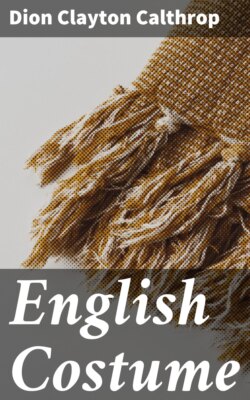Читать книгу English Costume - Dion Clayton Calthrop - Страница 27
На сайте Литреса книга снята с продажи.
THE MEN
ОглавлениеTable of Contents
There was a garment in this reign which was the keynote of costume at the time, and this was the surcoat. It had been worn over the armour for some time, but in this reign it began to be an initial part of dress.
Take a piece of stuff about 9 or 10 yards in length and about 22 inches wide; cut a hole in the centre of this wide enough to admit of a man’s head passing through, and you have a surcoat.
A MAN OF THE TIME OF JOHN (1199-1216)
Under this garment the men wore a flowing gown, the sleeves of which were so wide that they reached at the base from the shoulder to the waist, and narrowed off to a tight band at the wrist.
These two garments were held together by a leather belt buckled about the middle, with the tongue of the belt hanging down.
Broad borders of design edged the gowns at the foot and at the neck, and heraldic devices were sewn upon the surcoats.
King John himself, the quick, social, humorous man, dressed very finely. He loved the company of ladies and their love, but in spite of his love for them, he starved and tortured them, starved and beat children, was insolent, selfish, and wholly indifferent to the truth. He laughed aloud during the Mass, but for all that was superstitious to the degree of hanging relics about his neck; and he was buried in a monk’s cowl, which was strapped under his chin.
Silk was becoming more common in England, and the cultivation of the silkworm was in some measure gaining hold. In 1213 the Abbot of Cirencester, Alexander of Neckham, wrote upon the habits of the silkworm.
Irish cloth of red colour was largely in favour, presumably for cloaks and hoods.
The general costume of this reign was very much the same as that of Henry II. and Richard I.—the long loose gown, the heavy cloak, the long hair cut at the neck, the fashion of beards, the shoes, belts, hoods, and heavy fur cloaks, all much the same as before, the only real difference being in the general use of the surcoat and the very convenient looseness of the sleeves under the arms.
There is an inclination in writing of a costume one can visualize mentally to leave out much that might be useful to the student who knows little or nothing of the period of dress in which one is writing; so perhaps it will be better to now dress a man completely.
First, long hair and a neatly-trimmed beard; over this a hood and cape or a circular cap, with a slight projection on the top of it.
Second, a shirt of white, like a modern soft shirt.
Third, tights of cloth or wool.
Fourth, shoes strapped over the instep or tied with thongs, or fitting at the ankle like a slipper, or boots of soft leather turned over a little at the top, at the base of the calf of the leg.
Fifth, a gown, loosely fitting, buckled at the neck, with sleeves wide at the top and tight at the wrist, or quite loose and coming to just below the elbow, or a tunic reaching only to the knees, both gown and tunic fastened with a belt.
Sixth, a surcoat sometimes, at others a cloak held together by a brooch, or made for travelling with a hood.
This completes an ordinary wardrobe of the time.
